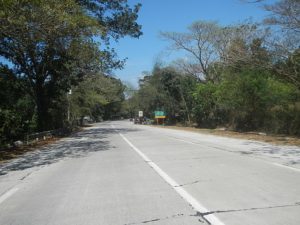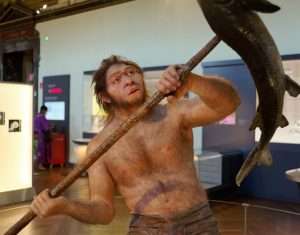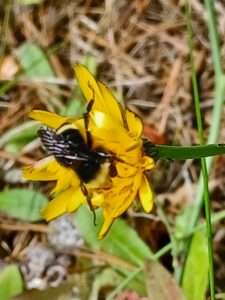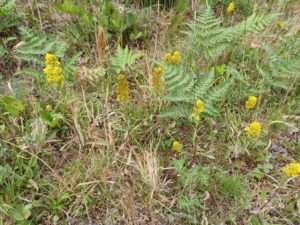 Imagine driving down a highway in a rural area with a group of other people. With every mile you pass literally millions of individual plants, from grasses to trees and all points in between. Yet with the exception of a few particularly odd, beautiful, or otherwise remarkable specimens, they go largely ignored as a backdrop to the trip, like a long green curtain lining either side of the road. On the other hand, let a deer graze in a field or a hawk land on a power line, and everyone in the car is likely to take notice and talk about it. This phenomenon of ignoring plants while giving extra attention to animals was termed “plant blindness” by J. H. Wandersee and E. E. Schussler.
Imagine driving down a highway in a rural area with a group of other people. With every mile you pass literally millions of individual plants, from grasses to trees and all points in between. Yet with the exception of a few particularly odd, beautiful, or otherwise remarkable specimens, they go largely ignored as a backdrop to the trip, like a long green curtain lining either side of the road. On the other hand, let a deer graze in a field or a hawk land on a power line, and everyone in the car is likely to take notice and talk about it. This phenomenon of ignoring plants while giving extra attention to animals was termed “plant blindness” by J. H. Wandersee and E. E. Schussler.
Plant Awareness Disparity > Plant Blindness
Before we go further, I want to discuss the term plant blindness itself. It was originally created to suggest that many people simply don’t see plants as individuals, and played on similar connotations of blindness as “blind spots” or being “blind to your faults”. In recent years this has come under fire as disability advocates have pointed out how this hangs a negative connotation on blindness. Biologist Kathryn M. Parsley wrote a detailed discussion of the problem with the term:
“Living life as a blind person is not a good example of, or metaphor for, the lack of visual attention to plants. Despite the fact that our visual systems do, quite literally, have something to do with ‘plant blindness,’ it is a metaphor that is insensitive to, and exclusive toward, members of the disabled community. As someone who is visually impaired myself, I can attest to how different the experience of living with a visual impairment is compared to that of simply being unaware of something in my environment.”
Dr. Parsley suggested “plant awareness disparity” instead of plant blindness. This term still centers the lack of attention we give to plants, but makes it more of a choice or habit rather than a complete inability to see them. It also doesn’t reinforce the negative stigma around visual disabilities. So for the remainder of this post I will be using this term rather than plant blindness.
Plants as Set Dressing Instead of Actors

Part of the problem is that we evolved to focus more on other animals as individuals. Our hominin ancestors spent millions of years having to watch their backs for larger, scarier predators, as well as the threat of enormous herbivores that could trample them at a moment’s notice. Once they became more omnivorous, it also paid for them to keep an eye out for smaller animals whose meat was a valuable source of protein and other nutrients. The plants they sought out, conversely, often grew in groups to be browsed, and instead of being focused on the entire plant, foraging hominins might only be interested in the high-calorie fruits.
But evolution isn’t the only reason we tend to look to animals more than plants. It’s cultural, too. Here in the United States, the bulk of biology class material is centered on animals, with less than 15% of the material focused on plants. Nature imagery is decreasing across the board as we become more urbanized and anthropocentric, and animals get the majority of what little is left, such as in the form of mascots and metaphors. People here are more able to name at least a few animal species, but often get stuck trying to list five plant species that grow in their own neighborhood.
And, to be quite honest, we’re rather self-centered. The more like us a living being is, the more importance we give to it. We love the symbolism of large, powerful mammals like bears, wolves, and elk, but we’re less enamored of smaller critters like mice, frogs, or goldfish. These still get more attention from us than plants or fungi, which usually only interest us if we can eat them, cultivate them, or make money off of them.
All of this leads us to seeing plants as the backdrop for the drama of animal experiences. Yet when you examine a healthy ecosystem in detail, you quickly realize that it is a complex interweaving of relationships among all of its living beings, including animals, plants, fungi, and an assortment of unicellular beings. The closest thing to a backdrop is the physical habitat in which these beings live, but even then geological, hydrological, and climatological forces all have frequent and often dramatic influences on the stories played out in a given ecosystem.
Look at the evolutionary history between an herbivorous animal and its preferred plant prey. Plants have evolved a wide variety of chemical and physical defenses to protect themselves against predation by animals. Thorns and other sharp things make eating these plants difficult to impossible. Chemicals make the plants unpalatable, or even poisonous. The herbivores, for their part, may evolve ways to get around these defenses and eat the plants anyway–at least until some random mutation gives an individual plant enough extra protection to help it survive a little better than its neighbors.
 Not that every interaction between plants and other beings is adversarial, of course. Plants often provide shelter to animals, and some even entice animals to eat various bits and parts such as nectar or fruit. In return they may get protection from more dangerous animals, or help with reproduction and spreading their seeds around. There are countless examples of these entwined relationships in every ecosystem on the planet.
Not that every interaction between plants and other beings is adversarial, of course. Plants often provide shelter to animals, and some even entice animals to eat various bits and parts such as nectar or fruit. In return they may get protection from more dangerous animals, or help with reproduction and spreading their seeds around. There are countless examples of these entwined relationships in every ecosystem on the planet.
Looking Beyond Our Bias
Of course, you need to be paying attention to those relationships in order to learn anything about them, and we haven’t always been good about that. We humans tend to be biased toward our fellow animals in the grand scheme of things, especially in Western societies. When I was first learning about biology in a Midwestern elementary school in the 1980s, the living beings of the world were presented in a sort of evolutionary hierarchy where those that showed up earliest were considered more primitive, and newcomers were considered advanced. Mammals were the pinnacle of evolution, much better than our ancient reptile ancestors, and certainly more worthy of note than their predecessors the amphibians and fish, and the entirety of the invertebrate world. Plants, being largely sedentary and without the senses we take for granted, were barely worth mentioning outside of some basic cellular biology discussions and the process of photosynthesis.
Today we still often see plants as “lesser” beings than animals. Yet every plant species that is alive today is every bit an evolutionary success as we are, insofar as their ancestry all the way back to the spark of life is no shorter than ours. While countless animal and plant (and other) species and their evolutionary histories have gone extinct, we share the planet with millions of other species whose adaptations to life’s challenges have all been successful enough to get them to this point. (Whether we all survive the Anthropocene is another story, but I digress.)
In order to combat plant awareness disparity, it is often necessary to consciously cultivate connections with plants. This is best begun by having physical contact with them. Kids and adults both have fewer opportunities to explore the natural world than they did a few decades ago; economically disadvantaged populations have even scarcer opportunities for time in greenspace. The good news is that plants are among the easiest beings to interact with, as they don’t run away like animals do, and unlike the fruiting bodies of fungi plants can be easily observed year-round. Many plants can be safely handled and explored, which allows people of all ages to get to know them more deeply as individuals.
This helps to spark curiosity, but we also need to normalize learning about plants. Photosynthesis is a really fascinating starting point about what makes plants so cool, but we need to be able to build upon that and teach more about plant communities, behaviors, and adaptations. This curriculum should be presented not as “how are plants supporting characters to animals”, but “plants as protagonists in their own stories.”

Finally, I am a huge advocate for learning how to identify beings in nature, to include plants. When we can recognize a given species of plant, it suddenly stands out to us rather than being just a part of that green curtain. And this repeats itself every time you learn a new plant. Do this enough times, and you start seeing that complex community of plants, which ones happen to be found together in similar habitats, and what their preferences are as far as light, soil, and hydration go, among other things. The plants, over time, become as individualized as the animals. And the phenomenon of plant awareness disparity fades, to be replaced with a wider, deeper, and more varied awareness of a wealth of amazing living beings of all sorts.
